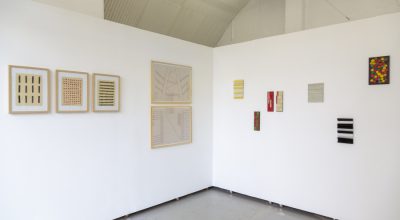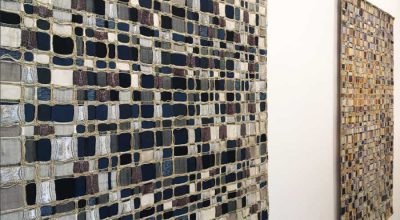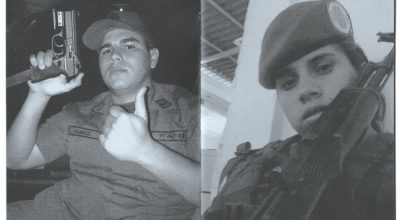
ALESSANDRO BALTEO-YAZBECK: SALTO ATRÁS
Let’s start with an anecdote that became a work. In 1994, Alessandro Balteo-Yazbeck had to spend many nights at a university other than his own. Therefore, he read and wandered in empty classrooms, and on unused blackboards, he developed an improvisation system: drawing links based on nodes and lines, which he understood as «hypothetical relationships» between people, objects, and ideas. These mental maps, or plots, which referred to real events, impossible to decipher, were erased the next day when professors arrived in their classrooms. Nevertheless, in order to fulfill his academic requirements, he resorted to that effective resource in ephemeral art expressions—documentation. Balteo-Yazbeck photographed only some of those drawn blackboards, which would later be exhibited as records of actions in her first solo show in Caracas, in 1997. One of them has now been rescued from his archive of «poetic documents» [1] to form part of his second solo exhibition at Carmen Araujo Arte.

What is Balteo-Yazbeck proposing with this gesture, with this incorporation, with this leap backwards in the genealogy of his own work? Commonly, his work has been read as a critical project in which, through strategies such as documentation, research, curatorship and museography, as well as the use of diverse media and supports (installations, photography, video, printed materials and found objects) he has delved into the «plots» related to the exercise of power, its discursive and propaganda mechanisms, both within the modernist period and in current political events.
In this sense, Balteo-Yazbeck has insisted on the juxtaposition of elements such as documents, handicrafts, souvenirs, prints, and narratives from the collective imaginary of his country of origin, Venezuela, both in proposals that directly address the tensions and problems of the Venezuelan people and in those in which he makes use of those «local resources» to tend and deploy, in other contexts, the relational practices with which he articulates, or weaves, his oeuvre.
«Salto atrás» could then be understood as a museographic device designed by Balteo-Yazbeck to trace a narrative arc that is structured from his early questioning of the past glories of local abstract art and is directed towards the construction of a set of cultural artifacts that are manifested as documents of the painful political and economic crisis of today’s Venezuela. With this operation he transitorily makes different temporalities coincide: those of his own artistic project, that of the Venezuelan nation, and that of the evolution of our so-called modernity in the context of the Cold War.
As a device, this «leap backwards», which appeals to the memory of a perverse colonial caste system, serves to point out the possibility, in any type of story, of the resurgence of forgotten traits, of recessive moments, which, when surfacing, reveal the crossovers and alterations that have come about through the course of events over time. But it is also effective to indicate that between the manifestations of a distant past and the present, the similarities may be greater than expected.


That is why «Salto atrás» is articulated, in the first instance, around a set of handmade chinchorros (hammocks), belonging to the series «Enredos Modernos–Chinchorros Soberanos» (Modern Entanglements–Sovereign Hammocks), which as metaphors of the nation’s fabric, serve the artist as a starting point to superimpose, not without irony, different historical times, cultural traditions and political-economic circumstances. Following the usual strategies in his work, with them he weaves a series of conceptual and formal relationships between different cultural artifacts to produce a set of documents of the future; vestiges of a traumatic period of the nation that function as the manifestation of a collective memory, reconstructed as an artwork.
For this purpose, he makes use of personal or found objects, collected or expressly elaborated, such as: the chinchorros made for this occasion [2] by the Roja’s family, traditional artisans from Carora–Venezuela, in red or black industrially produced «nylon», “Made in Venezuela”; an abacus brought from communist China in the early nineties; a poster produced by ANTIFA (a non-governmental political group) found in the streets of Berlin; the pages of a liberal American magazine; Venezuelan bills—now out of circulation. All these objects’ origins and materiality are traced and registered via wall labels in the gallery space.
These operations serves to privilege, on the one hand, the object itself as a signifying device, and on the other hand, to point out the way they are put into operation, the articulation that tends between them, through museographical practices associated with ethnographic institutions. Thus, by emulating these systems of taxonomy, cataloguing and exhibition of objects, it continues to weave the fabric of an imprecise time –composed of present, past and future moments, with jumps, continuities and discontinuities– over the nation’s fabric.
Nevertheless, although the local traces are evidently present in these installations, with the allusion to such concrete issues and circumstances as the problematic Oil condition of the Venezuelan state, its financial dependence on China, the hyperinflation experienced in its economy, or the trivialization of political discourses and their ideological extremes; in them are also nested some of the greatest fears of international geopolitics, which as modern specters of imperialism, the Cold War, nationalisms, and autocracies, reappear, together with others, mutated with new and different forms of political discourse and ideological extremes; as others, showing new faces, similar but different.



Returning to the anecdote at the beginning, in which the artist draws an abstract relations’ system [3] to establish another inscription of place –that of Venezuelan art– in the temporalities of this story (1994-2004-2022), produced by the dates of conception and production of the works. In the genealogy of Balteo-Yazbeck’s oeuvre, we can see the theoretical framework of his intentional formalism and concepts, the residues of an «anti-serial» abstract program [4], a questioning of the triumph of the kinetic illusion (the Cinetismo movement), and the search for alternative narratives and experiences to the hegemonic ones, in clear synchrony with the beginning of an agenda that, for more than a decade, Venezuelan curators, researchers and artists carried out to problematize the legacy of the modernist period in the Venezuelan nation. That is why, following Eliseo Sierra’s reflections, it is understood that Balteo-Yazbeck’s work went from the understanding of reality through a system of abstract associations to the deconstruction of these relationships, and that his critique «is not only based on our art history and its artists, but on the entire modern project and its political and social derivations [5].
Perhaps that is why it is difficult not to think of this gesture of producing a «déjà vu» inspired by Cézanne’s apples, by means of a series of arboreal drawings with a vocation for installation, as a crisis of the modern forms of representation of reality, as an attempt to structure and deconstruct the ways of articulating our relationship with the world. With this spatial and temporal dislocations that Balteo-Yazbeck has managed to summon in an intentionally fragmented piece, the artist proposes a performative act of memory that generates an experience of the past in the present, and –why not– a rhizomatic way of building a memory of the future, as he has already done on numerous occasions throughout almost three decades of artistic project.
[1] Sandra Pinardi defines as «poetic documents»: «fictitious, critical documents, which assume different problems in disturbing ways, but which function as documents (that is to say, they stretch the meanings towards the realm of the real, towards the facts)». In: Pinardi, Sandra, Sierra, Eliseo. «Instrumentalizados». Caracas: Carmen Araujo Arte, 2018. Available at: https://carmenaraujoar te.com/exhibiciones_63_ instrumentalizados_a-balteo- yazbeck. Accessed: 16 June, 2022.
[2] Since 2004, Balteo-Yazbeck has been inserting or juxtaposing works or objects by other authors in chinchorros with diverse provenances and materiality. While some have been exhibited, others have remained unpublished.
[3] Sierra, Eliseo. Ibidem.
[4] As «anti-serial» abstraction, Balteo-Yazbeck defines and proposes a reaction to the practices of artists who incorporated the use of the serial matrix, both, as a constructive element of their works and as a mechanism for the serial reproduction of objects, like in a production chain, for obvious commercial purposes.
[5] Sierra, Eliseo. Ibidem.
Salto atrás, by Alessandro Balteo-Yazbeck, was on view from July 3 to August 14, 2022 at Carmen Araujo Arte, Urbanización Sorokaima, Calle Rafael Rangel Sur, Secadero 2, Hacienda La Trinidad Parque Cultural, Caracas, Venezuela.
También te puede interesar
Sheroanawe Hakihiiwe & Luis Romero:venezuelan Pavilion
This year, the Venezuelan Pavilion failed to open its doors to the public during the preview days of Venice Biennale amongst the political turmoil that has taken over the country since the beginning of...
ESPACIO EXTENDIDO. MARÍA DÁVILA Y EDUARDO PORTILLO
La Galería Carmen Araujo Arte, en Caracas, presenta "Espacio extendido. María Dávila y Eduardo Portillo", una significativa exhibición de arte textil contemporáneo, que reúne piezas de estos reconocidos artistas venezolanos, concebidas y elaboradas conjuntamente...
FOTOGRAFÍA IMPRESA EN VENEZUELA, DE SAGRARIO BERTI
"Fotografía Impresa en Venezuela", de Sagrario Berti, tiene como objeto de estudio el inventario de libros y otros materiales impresos ilustrados con fotografías publicados en Venezuela desde la década del cuarenta hasta 2016. La...



